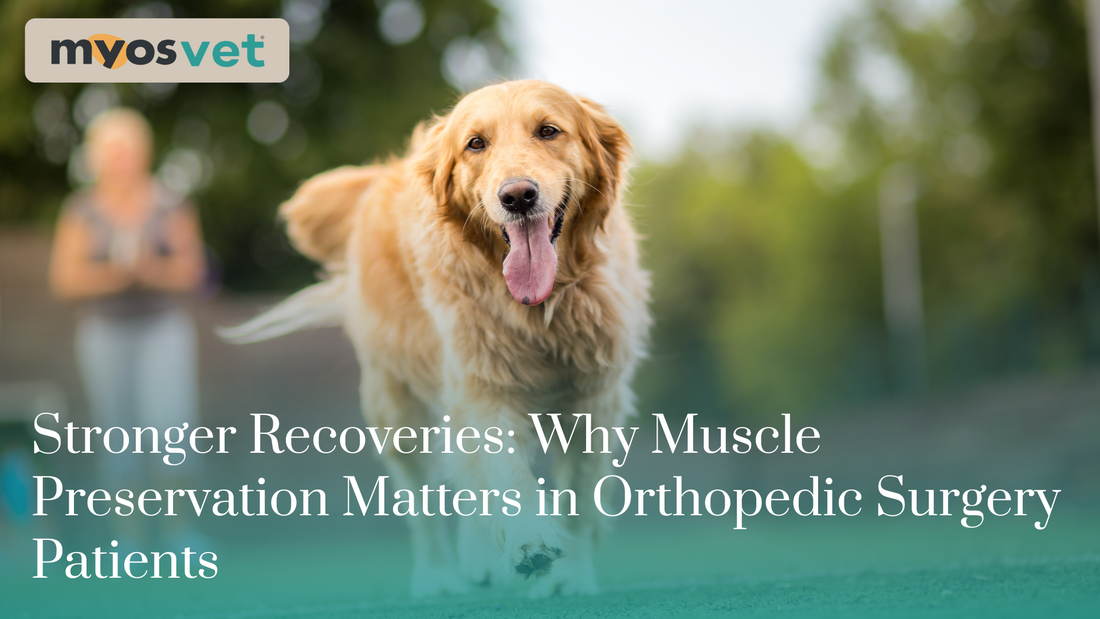
Stronger Recoveries: Why Muscle Preservation Matters in Orthopedic Surgery Patients
Share
Orthopedic procedures—whether cruciate ligament repair, hip surgery, or fracture fixation—are some of the most common and impactful surgeries veterinarians perform. While surgical technique and post-operative pain management are top priorities, one critical factor often overlooked is muscle preservation.
Healthy muscle is not just about mobility—it’s the foundation for joint stability, faster healing, and better long-term outcomes. Without proactive muscle support, pets are at risk of slower recoveries and reduced function. This is where Fortetropin®, the active ingredient in MYOS Canine and Feline Muscle Formula, becomes a valuable addition to post-surgical care.
1. The Challenge: Muscle Atrophy During Recovery
Even a short period of immobilization or reduced activity leads to rapid muscle loss:
- Disuse atrophy can begin in as little as a week.
- Joint instability increases when surrounding muscle weakens.
- Rehabilitation becomes harder, as patients have less strength to engage in therapeutic exercises.
For orthopedic patients, this creates a vicious cycle: weaker muscles slow recovery, which further prolongs inactivity, leading to more muscle loss.
2. The Role of Fortetropin® in Surgical Recovery
Fortetropin® is a clinically studied, all-natural ingredient shown to reduce muscle protein breakdown and support lean muscle mass. When integrated into a surgical recovery plan, it helps break the cycle of atrophy by:
- Preserving existing muscle during post-op rest.
- Supporting rehabilitation efforts, making it easier for patients to regain strength.
- Improving joint stability, reducing strain on surgical repairs.
- Enhancing overall mobility, leading to better long-term outcomes.
By maintaining stronger muscles, Fortetropin helps set patients up for a smoother, more successful recovery.
3. Clinical Applications
Cruciate Ligament Repairs
Muscle atrophy around the stifle joint often compromises recovery. Fortetropin supports quadriceps and hamstring strength, aiding in joint stabilization and faster return to normal function.
Fracture Repairs
Patients often require extended periods of rest post-fixation. Supplementing with Fortetropin helps preserve muscle during immobilization, reducing the steep decline in strength once activity resumes.
Hip Surgery Patients
In both femoral head ostectomy (FHO) and total hip replacement, surrounding muscle strength is critical for functional recovery. Fortetropin supports the lean mass needed to compensate for structural changes.
4. Integrating Muscle Support into Recovery Protocols
Veterinarians can easily incorporate Fortetropin into recovery plans:
- Early introduction: Start supplementation as soon as possible post-surgery to offset early atrophy.
- Pair with rehabilitation: Use alongside physiotherapy, underwater treadmill, or controlled leash walking for best results.
- Communicate with clients: Highlight the importance of muscle health in surgical outcomes—clients are often motivated to invest in strategies that ensure the success of their pet’s procedure.
Conclusion
Successful orthopedic surgery isn’t just about bones and joints—it’s about the muscles that support them. Preserving and rebuilding muscle during recovery can be the difference between a pet regaining full function or struggling long-term.
Fortetropin offers veterinarians a powerful, natural tool to protect muscle mass, support rehabilitation, and improve surgical outcomes. By making muscle health a priority, we can help patients return to activity faster, stronger, and with greater resilience.
